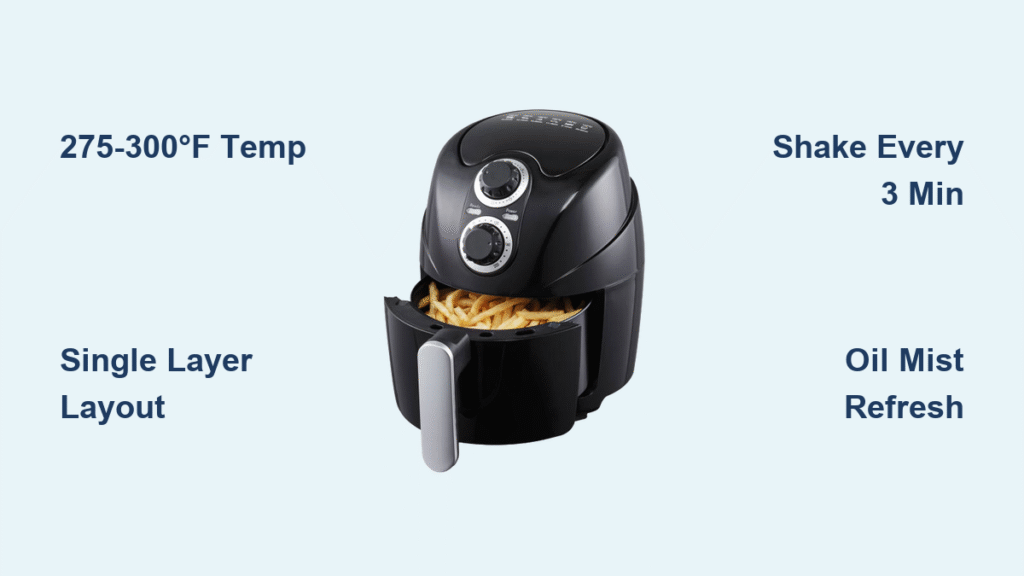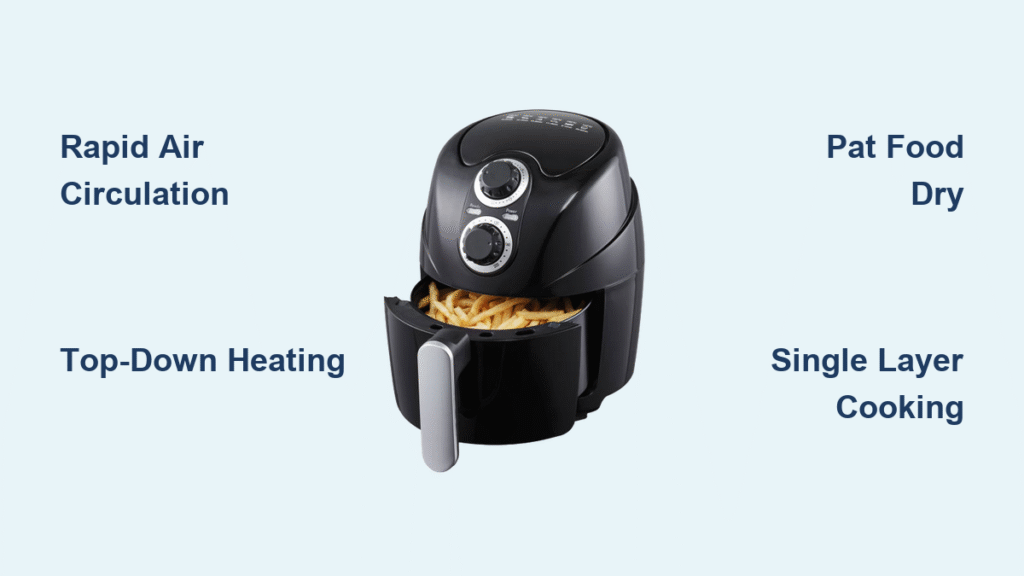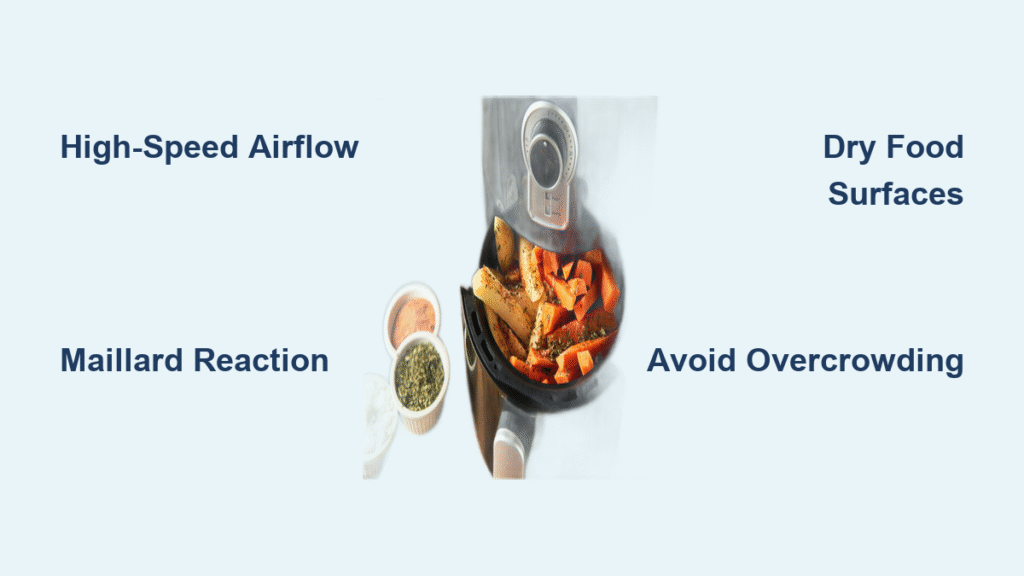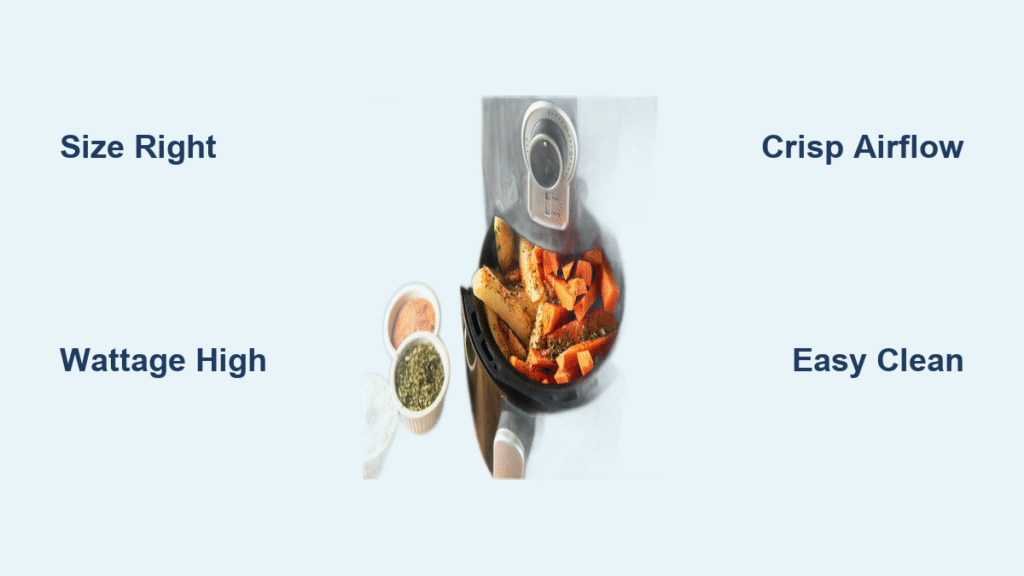Your air-fried chicken wings have reached perfect crispness, but dinner guests are running 20 minutes late. Instead of watching your carefully prepared meal turn cold and soggy, your air fryer can become a professional-grade warming station. Unlike microwaves that create rubbery textures or conventional ovens that dry out food, the air fryer’s rapid hot air circulation maintains safe serving temperatures while preserving that crucial crunch. This guide reveals exactly how to keep food warm in an air fryer for up to 30 minutes without compromising quality—transforming last-minute delays from disasters into seamless service opportunities.
Mastering this technique requires precise temperature control and strategic food arrangement. The enclosed basket design ensures hot air reaches every surface—including the bottom—so food warms evenly without cold spots. By following these science-backed methods, you’ll maintain restaurant-quality texture while keeping food safely above 140°F. Let’s turn your countertop appliance into your secret weapon for stress-free entertaining.
Why 275-300°F Is the Perfect Air Fryer Warming Zone

Setting the correct temperature is non-negotiable for successful food warming. Your air fryer must operate between 275-300°F to maintain safe temperatures without overcooking. Higher settings trigger continued cooking that dries out proteins and hardens cheese, while lower temperatures risk entering the food safety “danger zone” below 140°F. This narrow band leverages the appliance’s rapid air circulation to distribute heat evenly without moisture loss.
For delicate proteins and baked goods, 275°F is your ideal setting. This gentle heat preserves juices in steak slices and burger patties while keeping pastry layers flaky. It prevents cheese from hardening on pizza and stops custards from overcooking. For crispy favorites like fries and wings, maintain 300°F to reactivate breading without burning. This higher setting keeps oil molecules active on the surface, refreshing crunch that would otherwise fade during standing time.
Critical Temperature Reference for Common Foods
| Food Type | Exact Hold Temp | Max Safe Time | Pro Texture Tip |
|---|---|---|---|
| Thin-crust pizza | 300°F | 8-12 min | Single-layer placement prevents steam buildup |
| French fries | 300°F | 5-8 min | Shake basket at 3-minute mark for even crispness |
| Steak slices | 275°F | 4-6 min | Loosely wrap in foil to lock in juices |
| Chicken wings | 300°F | 6-8 min | Sauce AFTER warming to prevent burning |
| Burger patties | 275°F | 4-5 min | Warm buns separately for 90 seconds |
Always verify food has reached 165°F internally before switching to warm mode. Use an instant-read thermometer on the thickest portion—this isn’t optional for food safety. Digital air fryers with “Keep Warm” presets simplify this transition, but manual models require precise adjustment within 30 seconds of cooking completion.
5-Step Method to Warm Food Without Drying It Out
Skipping any step in this process risks texture failure or food safety breaches. Follow this exact sequence for foolproof results every time you need to keep food warm in an air fryer.
1. Confirm 165°F Minimum Temperature
Insert your thermometer into multiple spots of dense foods like chicken or burgers. If readings dip below 165°F, reheat first—never start warming cold food. This critical checkpoint prevents bacterial growth during holding.
2. Immediately Drop to Holding Temperature
Reduce heat to 275-300°F within 30 seconds of cooking completion. Delaying this transition allows residual heat to overcook exteriors while interiors stay cold. For oven-style air fryers, use rack inserts to maximize capacity without overcrowding.
3. Optimize Basket Layout for Airflow
Place flat items like pizza in single layers with space between slices. Stack chunkier foods like roasted potatoes up to the MAX line, but never let pieces touch. Use perforated parchment liners—they protect non-stick coatings while allowing full air circulation. Never pile food beyond the basket’s capacity; this traps steam and creates sogginess.
4. Rotate Every 3 Minutes
Set a phone timer for consistent rotation. Shake the basket vigorously for fries and wings, or flip large items like burger patties with silicone-tipped tongs. This redistributes heat and prevents hot spots that dry out edges while centers stay cool.
5. Refresh Moisture Strategically
At the 5-minute mark, lightly mist dry surfaces with oil using a refillable sprayer. Avoid aerosol cans—their propellants degrade non-stick coatings. For pizza with hardening cheese, tent loosely with foil instead of spraying.
Top Foods That Shine When Warmed in an Air Fryer

Not all foods respond equally to air fryer warming. Understanding these distinctions prevents disappointing results and maximizes your appliance’s potential.
Air Fryer Warming Superstars
- Pizza (both thin and thick crust): Circulating air maintains crust integrity while keeping cheese perfectly melted. Thick-crust slices benefit from loose foil tents to prevent scorching.
- Fried foods (fries, wings, spring rolls): The 300°F setting reactivates surface oils, restoring crispness that would fade on the counter. Shake baskets midway for uniform results.
- Roasted vegetables: Carrots and potatoes retain caramelized exteriors while interiors stay tender. A light oil mist at 4 minutes refreshes their glossy finish.
- Baked goods (croissants, puff pastry): At 275°F, flaky layers stay distinct without drying out—critical for delicate pastries that harden in conventional ovens.
Foods That Fail Miserably
- Leafy greens: High-velocity air turns salads into shredded messes within minutes. Keep these refrigerated until plating.
- Liquid-based dishes: Soups and stews leak through basket perforations, creating dangerous spills and uneven heating.
- Creamy casseroles: Surfaces develop tough, dried-out crusts while centers remain cold—a fundamental flaw of dry-heat warming.
- Soft-centered desserts: Continued heat eliminates desirable gooey textures in molten cakes or custards.
Fix These 4 Common Warming Problems Immediately

Even experienced users encounter issues when learning how to keep food warm in an air fryer. These targeted solutions rescue meals without starting over.
Problem: Food Drying Out Mid-Warm
Cause: Temperature set 25°F too high or exceeding maximum hold time.
Fix: Immediately drop to 275°F, mist with oil, and serve within 3 minutes. Never exceed 15 minutes at 300°F for crispy foods.
Problem: Soggy Bottoms on Fries
Cause: Steam trapped between food and basket during stacking.
Fix: Spread in single layer with space between pieces. If already soggy, run a 30-second burst at 390°F to re-crisp—then serve immediately.
Problem: Uneven Heating in Large Batches
Cause: Overcrowded basket blocking airflow channels.
Fix: Reduce batch size by 30%. Shake basket every 2.5 minutes instead of 3, and rotate basket 180 degrees during the cycle.
Problem: Hardened Cheese on Pizza
Cause: Direct exposure to high heat without moisture barrier.
Fix: Tent loosely with foil immediately after placing in basket. For deep-dish pizza, reduce temperature to 275°F and check at 7 minutes.
Game-Day Wing Station: A Real-World Application
When hosting parties, this proven wing-warming technique prevents last-minute stress. Cook wings to 165°F internal temperature, then switch air fryer to 300°F. Load no more than 8 wings per batch in single-layer formation—overcrowding causes steaming instead of crisping. Crucially, keep sauce separate and toss wings just before serving; pre-sauced wings burn within 4 minutes under warming heat. Set two timers: one for 3-minute basket shakes, and another for 7-minute maximum hold time. At the 5-minute mark, mist wing tips with oil using your refillable sprayer to maintain appetizing sheen. This method keeps wings hot and crisp for the entire first quarter—plenty of time for guests to arrive.
Must-Have Tools for Perfect Air Fryer Warming
Skip these essentials and you’ll compromise both safety and results when trying to keep food warm in an air fryer.
Non-Negotiable Gear:
– Instant-read digital thermometer (verify 165°F minimum before warming)
– Perforated parchment liners (allow airflow while preventing sticking)
– Refillable oil sprayer (for moisture refresh without sogginess)
– Aluminum foil (for strategic tenting of delicate items)
Worthwhile Upgrades:
– Rack inserts for oven-style air fryers (double capacity without crowding)
– Silicone-tipped tongs (safe handling of hot, slippery foods)
– Mini magnetic timer (attach to fryer for rotation reminders)
Non-Negotiable Safety Rules for Food Warming
Ignoring these protocols risks foodborne illness—even with the best how to keep food warm in an air fryer techniques.
Time and Temperature Boundaries:
– Never hold food below 140°F for more than 2 hours cumulative (including cooking time)
– Maximum warm-hold duration: 30 minutes total at 275-300°F
– After warming, cool leftovers rapidly to 40°F or below within 2 hours
– Reheat only once after initial cooking—warming counts as part of this cycle
Leftover Protocol:
Refrigerate within 2 hours of cooking completion. Consume chilled leftovers within 3-4 days, or freeze for longer storage. Always reheat stored items to 165°F before serving—never return partially eaten food to the air fryer for warming.
Your air fryer transforms from a simple cooker into a precision warming station when you master these temperature-controlled techniques. By respecting the 275-300°F sweet spot, arranging food for optimal airflow, and never exceeding 30 minutes of holding time, you’ll serve consistently crisp, hot food regardless of dinner delays. Remember: verify temperatures, rotate diligently, and rescue drying surfaces with strategic oil misting. With this knowledge, last-minute schedule changes become trivial—and your reputation as a stress-free host is secured. The next time guests run late, simply activate your air fryer’s warming magic while setting the table: perfectly crisp food awaits.





